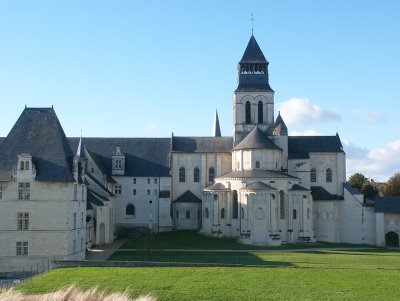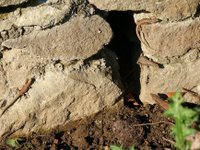Last time we visited France both Susan and I caught something that feels like the 'flu, which has laid us low for a couple of weeks. We're back on deck now, so here goes:
On Sunday we decided to play tourist and visit Fontevraud Abbey. We left Preuilly sur Claise under leaden skies, expecting the day to stay rainy and overcast. We stopped at a rest area just outside Preuilly to take a photo of the colours of the forest around Boussay, before heading towards Chatellerault.
 Once past Chatellerault we were on the route D749, a Roman road of amazing straightness with only one bend between Chatellerault and Richelieu, a distance of 30km. Richelieu itself is well worth a visit, being a planned "new town" designed at the behest of Cardinal R himself. The covered market place is amazing, but at the moment the open market is undergoing a rather severe rebuild, and more resembles the battlefields of the Somme than a quaint market.
Once past Chatellerault we were on the route D749, a Roman road of amazing straightness with only one bend between Chatellerault and Richelieu, a distance of 30km. Richelieu itself is well worth a visit, being a planned "new town" designed at the behest of Cardinal R himself. The covered market place is amazing, but at the moment the open market is undergoing a rather severe rebuild, and more resembles the battlefields of the Somme than a quaint market. We arrived in Fontevraud just in time for lunch. This was taken at a fairly uninspring Creperie, and was more just refuelling than a gastronomic event. We decided on gallettes (a savory, buckwheat crepe) because it was a way of avoiding having two 3 course meals a day, which seems to have become our standard.
We arrived in Fontevraud just in time for lunch. This was taken at a fairly uninspring Creperie, and was more just refuelling than a gastronomic event. We decided on gallettes (a savory, buckwheat crepe) because it was a way of avoiding having two 3 course meals a day, which seems to have become our standard.The Abbey itself is really very interesting, even though Susan and I were slightly dismissive at first of it's "newly minted" look. After the revolution it became a prison, and remained as such until 1963. By all accounts it was treated extremely poorly, with even the abbey church itself becoming a 2 level dormitory.The restoration of the abbey complex has been the largest resoration program in France, and once you get past the shiny new parts and find the buidings yet to be worked on, you can see just how much they have had to do. Parts of the abbey are still roofed in corrugated iron and held up with railways sleepers. There are walls patched with bits of old door and metal sheets, and it is obvious that the pidgeons haven't been helping.
The Back of the Abbey, Fontevraud
 The reason we wanted to see Fontevraud is the Tombs of Henry II of England, his wife Eleanor of Aquitaine, their son King Richard I of England, and his sister-in-law Isabella of Angoulême. Eleanor of Aquitaine became a nun at the abbey after Henry's death. She is a really very interesting woman - one of those middle ages types that some modern day feminists seem to ignore because she doesn't fit in with the "no powerful women" syndrome. (Simon's rant, now over). I had borrowed Alison Wier's book from the library before we left London, which primed me nicely for the visit.
The reason we wanted to see Fontevraud is the Tombs of Henry II of England, his wife Eleanor of Aquitaine, their son King Richard I of England, and his sister-in-law Isabella of Angoulême. Eleanor of Aquitaine became a nun at the abbey after Henry's death. She is a really very interesting woman - one of those middle ages types that some modern day feminists seem to ignore because she doesn't fit in with the "no powerful women" syndrome. (Simon's rant, now over). I had borrowed Alison Wier's book from the library before we left London, which primed me nicely for the visit.The interior of the Abbey church itself is very plain, with just the effigies and some remnents of wall painting (which Susan remembers, but I don't).
Henry II and Eleanor

 The rest of the abbey buildings are interesting, particularly the kitchen. This was restored in 1906 and given pointy finials to the chimneys, which although not terribly authentic, are quite fun. There are some painted chambers which include portraits of the nuns of the abbey of the time in the scenes of the passion. Some of them are quite humerous, but there are definitely a few pingouins des combat amongst them!
The rest of the abbey buildings are interesting, particularly the kitchen. This was restored in 1906 and given pointy finials to the chimneys, which although not terribly authentic, are quite fun. There are some painted chambers which include portraits of the nuns of the abbey of the time in the scenes of the passion. Some of them are quite humerous, but there are definitely a few pingouins des combat amongst them!
 Also well worth a visit are the gardens, which are being restored. We were delighted to see some animal life, even this late in the year. The Violet Carpenter Bees were buzzing around the Bay Trees, and a family of European Wall Lizards (Podarcis muralis) were making the most of the late autumn sunshine.
Also well worth a visit are the gardens, which are being restored. We were delighted to see some animal life, even this late in the year. The Violet Carpenter Bees were buzzing around the Bay Trees, and a family of European Wall Lizards (Podarcis muralis) were making the most of the late autumn sunshine.Simon
